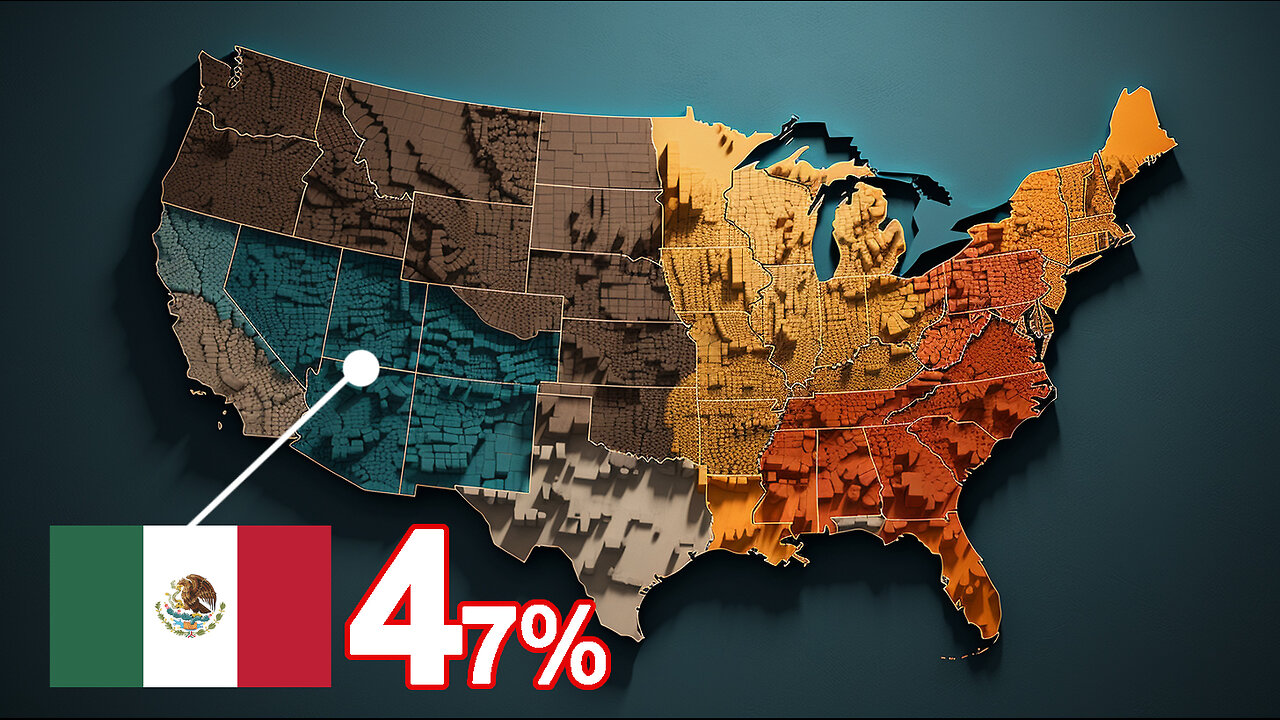Premium Only Content

Where Illegal Immigrants in the US Are Coming From
Illegal immigration is a complex issue that has significant social, economic, and political ramifications.
Understanding the origins of illegal immigrants in the United States is crucial for developing effective immigration policies and addressing the root causes of migration. This essay will explore the various countries from which illegal immigrants come to the US, analyzing the reasons behind their emigration and providing data on immigration rates for each country.
Mexico.
Mexico serves as the primary wellspring of illegal immigrants to the United States, a reality underscored by the staggering numbers of individuals crossing the border illicitly in pursuit of improved economic prospects. The lure of economic advancement acts as a powerful magnet, drawing countless Mexicans to brave the perilous journey northward. Within the intricate tapestry of push factors propelling this mass exodus, pervasive poverty, widespread unemployment, and meager wages emerge as prominent catalysts, compelling individuals to seek greener pastures beyond their national borders.
Poverty, an omnipresent specter haunting many Mexican communities, constrains livelihoods and stifles aspirations, leaving swathes of the population grappling with dire socioeconomic conditions. Coupled with limited access to quality education and employment opportunities, this endemic poverty perpetuates a cycle of disenfranchisement, propelling individuals to seek refuge in the promise of a better life across the border.
Unemployment further exacerbates the plight of many Mexicans, rendering them susceptible to the siren call of migration in search of gainful employment. With job scarcity plaguing various sectors of the Mexican economy, particularly in rural areas, where agricultural livelihoods face mounting challenges, the allure of steady employment in the US holds undeniable appeal for countless individuals striving to support themselves and their families.
Moreover, the pervasive issue of low wages compounds the economic woes afflicting many Mexicans, rendering even those fortunate enough to secure employment susceptible to financial instability and meager living standards. The stark disparity between wages in Mexico and the United States serves as a potent incentive for individuals to risk the arduous journey across the border in pursuit of greater earning potential and the promise of a more prosperous future.
Yet, beyond the economic impetus driving Mexican migration, the specter of violence and insecurity looms large, casting a shadow of fear and uncertainty over many communities. Certain regions of Mexico grapple with endemic violence stemming from organized crime, drug trafficking, and internal conflict, rendering them veritable hotbeds of instability and peril. Faced with the daily threat of violence and coercion, individuals and families are left with little choice but to flee in search of sanctuary and security.
In light of these formidable challenges, the allure of the United States as a beacon of safety, stability, and opportunity remains irresistible for millions of Mexicans. Despite the perils and uncertainties inherent in the journey, the promise of a better life propels countless individuals to embark on the arduous trek northward, braving inhospitable terrain, harsh climates, and the ever-looming specter of detection and deportation.
Thus, it comes as little surprise that recent data affirms Mexico's status as the predominant source of illegal immigrants in the United States, with approximately 47% of undocumented migrants hailing from its shores. This stark reality underscores the urgent need for comprehensive immigration reform and targeted interventions aimed at addressing the root causes of migration, from economic disenfranchisement to pervasive violence, in order to forge a more equitable and sustainable future for all.
Central America (Guatemala, Honduras, El Salvador).
Countries in Central America, particularly Guatemala, Honduras, and El Salvador, also contribute significantly to illegal immigration to the US. High levels of poverty, gang violence, and political instability push many people to leave their homes and seek refuge in the United States. The Northern Triangle countries, as they are often referred to, have some of the highest homicide rates in the world, prompting many to flee in search of safety. Economic opportunities and family reunification also motivate migration from this region. Combined, these three countries account for approximately 18% of illegal immigrants in the US.
China.
China stands out as a significant contributor to the tapestry of illegal immigration to the United States, with a steady stream of Chinese nationals traversing borders through various clandestine avenues, including overstaying visas and navigating illicit border crossings. This influx reflects a confluence of factors, spanning economic imperatives, political disillusionment, and aspirations for personal and familial advancement.
At the heart of this migration narrative lies a pursuit of economic prosperity, with many Chinese individuals lured by the promise of better job opportunities and higher wages awaiting them in the land of opportunity. China's rapid economic transformation, while marked by unprecedented growth and development, has also engendered stark inequalities and disparities, leaving swathes of the population grappling with limited prospects for upward mobility and financial stability. In the face of mounting economic pressures and constrained livelihoods, the allure of the United States as a bastion of economic opportunity and prosperity looms large, compelling many to embark on the perilous journey in search of a brighter future for themselves and their families.
The intertwining dynamics of economic necessity and political disillusionment underscore the complex motivations driving Chinese migration to the United States, with recent data revealing that approximately 19% of illegal immigrants in the US originate from China.
Before we moving forward make sure you subscribe to Top Things To Know so you don't miss out on more videos like this!
India.
India emerges as a prominent player in the landscape of illegal immigration to the United States, with a notable contingent of individuals from the subcontinent undertaking clandestine journeys in pursuit of brighter horizons. Against the backdrop of a diverse array of push and pull factors, spanning economic, familial, and educational considerations, Indian migrants navigate complex pathways to seek refuge and opportunity on American shores.
Economic imperatives loom large in shaping the migration narrative for many Indians, as pervasive poverty, staggering unemployment rates, and limited job prospects constrain livelihoods and aspirations within the homeland. Despite India's status as a burgeoning economic powerhouse, marked by rapid industrialization and technological innovation, vast segments of the population grapple with systemic inequalities and structural barriers to economic advancement. In the face of stagnant wages, precarious employment opportunities, and entrenched poverty, the allure of the United States as a bastion of economic opportunity and prosperity holds undeniable appeal, propelling many Indians to undertake the arduous journey in search of greener pastures and a shot at realizing their dreams of financial security and upward mobility.
Recent estimates indicate that approximately 8% of illegal immigrants in the United States hail from India, underscoring the enduring allure of the American dream and the resilience of individuals determined to seize upon opportunities for a better life. Yet, amid the prevailing narrative of aspiration and opportunity, it is imperative to recognize the underlying challenges and structural injustices driving this migration phenomenon, from economic inequality to bureaucratic barriers, and work towards fostering a more inclusive, equitable, and compassionate approach to immigration policy.
Other Countries.
Beyond the focal points of immigration from Mexico, China, and India, the mosaic of illegal immigrants in the United States extends far and wide, drawing from a rich tapestry of nations spanning continents and cultures. Indeed, approximately 8% of undocumented migrants hail from a diverse array of countries across the globe, reflecting the complex interplay of geopolitical, economic, and environmental factors shaping migration dynamics on a global scale.
In Africa, the Caribbean, Southeast Asia, and beyond, individuals embark on perilous journeys in search of sanctuary and opportunity, propelled by a myriad of push and pull factors. Economic instability serves as a potent catalyst for migration, as individuals grapple with stagnant wages, limited job prospects, and entrenched poverty within their home countries. In regions wracked by political persecution and civil unrest, the specter of violence and coercion compels many to flee in search of safety and security, seeking refuge in countries where the promise of freedom and democracy beckons.
Conflict and instability further exacerbate the plight of millions, driving displacement and mass migration on an unprecedented scale. From war-torn regions in the Middle East to fragile states in Sub-Saharan Africa, the ravages of conflict and violence render entire populations vulnerable to displacement, forcing individuals to undertake perilous journeys in search of safety and respite from the chaos and turmoil engulfing their homelands.
Moreover, the specter of environmental disasters looms large over many communities, as climate change exacerbates existing vulnerabilities and threatens livelihoods across the globe. From rising sea levels and extreme weather events to desertification and food insecurity, the impacts of climate change compel many to seek refuge in countries where the promise of stability and resilience offers a glimmer of hope amid uncertainty and upheaval.
While the percentage of illegal immigrants from each of these countries may be smaller compared to major sources like Mexico and Central America, they collectively contribute to the rich tapestry of illegal immigration in the United States, enriching the cultural fabric and demographic makeup of the nation. Yet, amid the prevailing narrative of aspiration and opportunity, it is imperative to recognize the underlying challenges and structural injustices driving this migration phenomenon, from economic inequality to environmental degradation, and work towards fostering a more inclusive, equitable, and compassionate approach to immigration policy. By addressing the root causes of migration and forging pathways to legal status and integration, policymakers can create a more just and humane immigration system that upholds the dignity and rights of all individuals, regardless of their country of origin.
Conclusion.
Illegal immigration to the United States is a multifaceted issue shaped by a combination of economic, political, and social factors. Understanding the countries from which illegal immigrants originate and the reasons behind their emigration is essential for developing comprehensive immigration policies and addressing the root causes of migration. By addressing underlying issues such as poverty, violence, and political instability in countries of origin, policymakers can work towards creating a more equitable and sustainable approach to immigration.
-
 LIVE
LIVE
Donald Trump Jr.
3 hours agoBye Mitch, plus Kash confirmed, Interview with AJ Rice | Triggered Ep.218
3,615 watching -
 41:18
41:18
Kimberly Guilfoyle
3 hours agoToday, We Kash in on Equal Justice, Live with Ryan Walters & Daniel Turner | Ep.198
28.5K12 -
 1:36:50
1:36:50
Redacted News
2 hours agoThe TRUTH in Ukraine has been EXPOSED by Trump and they are melting down | Redacted w Clayton Morris
57.8K63 -
 2:05:35
2:05:35
The White House
3 hours agoPresident Trump Hosts a Reception Honoring Black History Month
22.2K23 -
 1:02:57
1:02:57
In The Litter Box w/ Jewels & Catturd
23 hours agoKASH CONFIRMATION TODAY! | In the Litter Box w/ Jewels & Catturd – Ep. 746 – 2/20/2025
60.6K48 -
 56:44
56:44
VSiNLive
2 hours ago $2.03 earnedFollow the Money with Mitch Moss & Pauly Howard | Hour 1
34K1 -

John Crump Live
6 hours agoUSA v. Canada! Bigger Than Just A Game
7.56K1 -

Revenge of the Cis
3 hours agoEpisode 1450: Wet Work
24.1K1 -
 3:36:29
3:36:29
vivafrei
9 hours agoKash Patel Confirmation Hearing LIVE! Jan. 6'er Kicked Out of CPAC? DOGE Wins in Court? & MORE!
241K232 -
 5:08:38
5:08:38
Barry Cunningham
8 hours agoTRUMP DAILY BRIEFING: KASH PATEL VOTE | WHITE HOUSE PRESS CONFERENCE | DOGE UPDATE
44K23